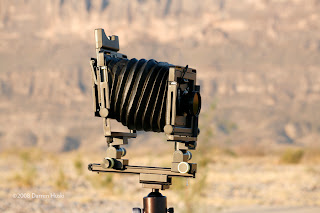
People often want to know what it is like to work with a large format camera. I usually just smile and say it is about the same as a 35mm camera, just bigger.
But it is really so much more.
Large Format, gives you the ability to do more than any DSLR or 35mm could. I can make so many adjustments that I have full control of the image in a way you could never have with any other kind of camera.
As a landscape photographer that allows me to have what amounts to infinite focus-the rock at 6" to the mountain at 6 miles and everything in between. It allows me to keep lines straight on a tree trunk or to make them wonky. It puts the photographer farther into the realm of photography than anything else.
The image here is of the camera set up on Terlingua Creek in Big Bend National Park as I was photographing the creek. This somewhat of a 3/4ths view lets you see some of what the camera can do. I am using my longest lens, a 210mm (about equal to a 60mm if you use a 35mm camera or a full frame DSLR). Note I am using most of my rail and with this 30cm rail could not use a much longer lens. Also note the bellows is the soft leather wide angle bellows which works nicely with this lens although it is about the limit of length too. The camera is pointed slightly down as I am photographing the stream. The rear standard is raised-this lowers the view so I am seeing even more stream and less sky. The rear standard is also tilted back-this most basic of movements helps bring the entire stream into sharp focus. Finally note the Quickload holder is on the top. That means I unclipped and rotated the ground glass. This allows me to flip between vertical and horizontal compositions without moving the camera (can't do that in 35mm). It keeps the camera centered over the tripod too. It is also something that takes just about two seconds to do-so it is quick and easy.
I am ready to take the image. All I would need to do is set the lens and get a sheet of film.
Further note, this camera is entirely mechanical and manual. From focus to setting the lens, to using the cable release it is all manual. You even need a separate light meter. It does not get much simpler than this. It also does not get as much of open ended creativity as this.
You should try one.










